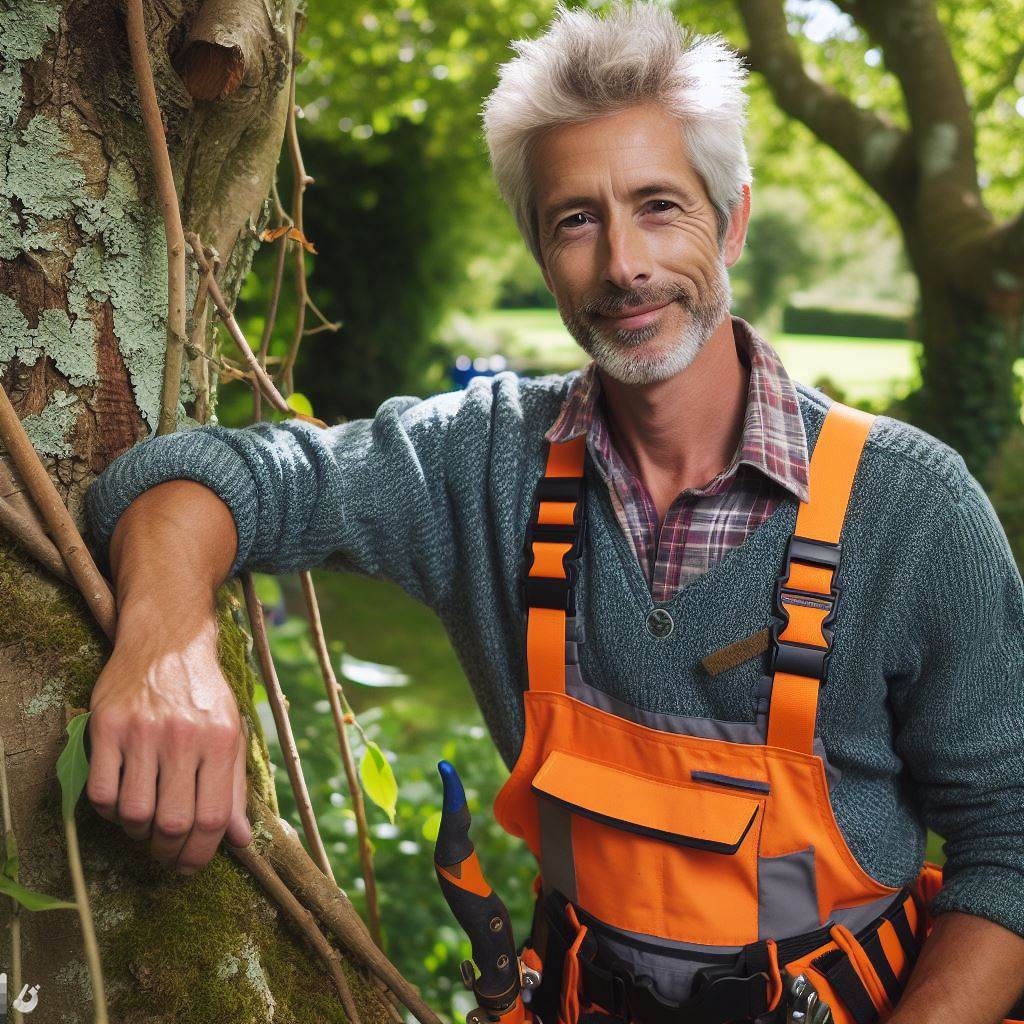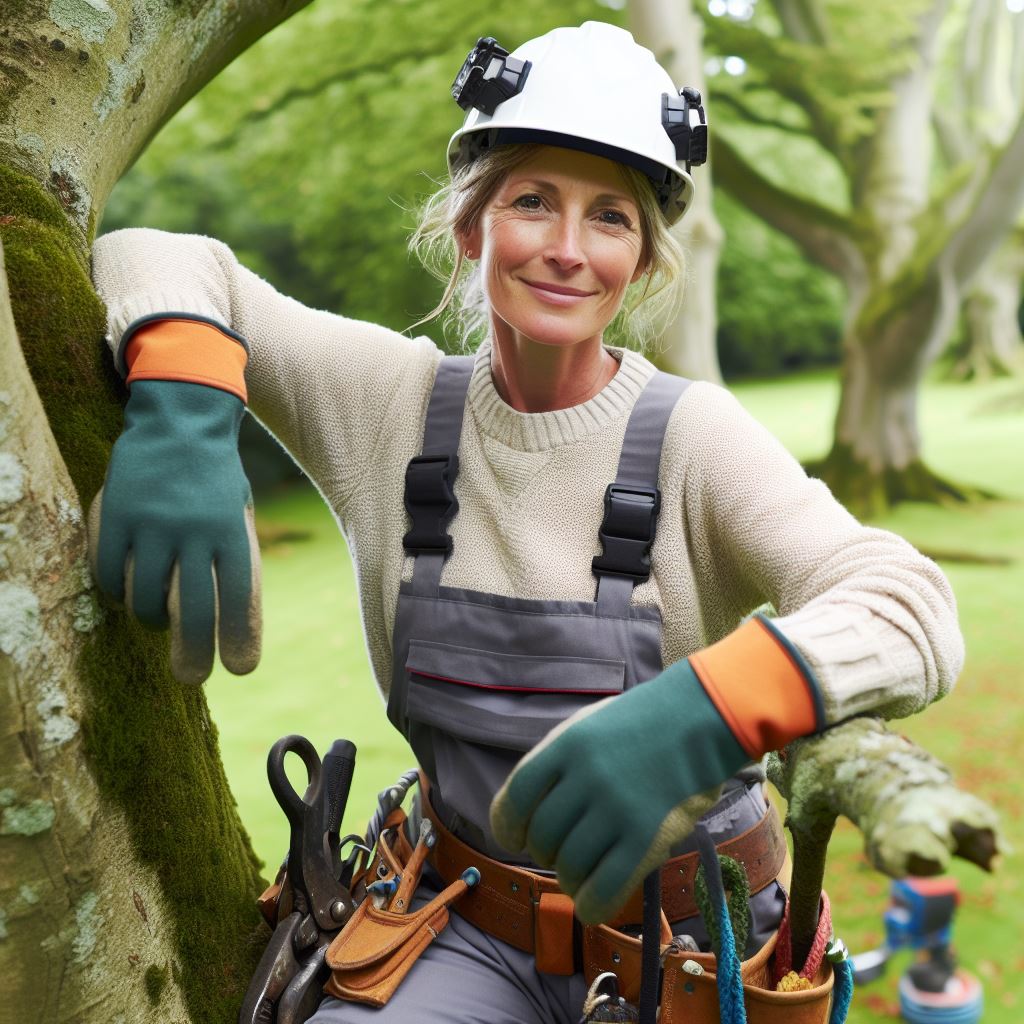Introduction
Arboriculture practices refer to the cultivation and management of trees, shrubs, and other woody plants.
Staying updated with the latest technology in arboriculture is crucial for several reasons.
It helps improve efficiency, safety, and sustainability in tree care operations
This blog post delves into the exciting realm of technology in modern arboriculture practices.
We will explore cutting-edge tools and techniques that are transforming the field, from drones for tree inspections to robotics for intricate pruning and removal tasks.
By embracing these advancements, arborists can enhance their services, improve tree health, and contribute to a greener future.
By understanding and adopting these latest practices, arborists can enhance their work and provide better care for trees and landscapes.
Traditional Methods in Arboriculture
Brief Overview of Traditional Practices in Arboriculture
- Pruning Techniques: Arborists historically employed hand tools for precision pruning, shaping trees for aesthetics and health.
- Tree Climbing and Rigging: Traditional arborists skillfully climbed trees, using ropes and pulleys for controlled limb removal.
- Soil Aeration and Fertilization: Manual soil aeration and application of organic fertilizers were common practices to enhance tree vitality.
Limitations and Challenges
- Efficiency Concerns: Traditional methods, though effective, often consumed more time compared to modern equipment.
- Risk of Injury: Climbing without advanced safety gear posed risks, leading to higher incidents of arborist injuries.
- Limited Scale: Traditional practices are less scalable, making it challenging for arborists to manage large-scale projects efficiently.
In exploring traditional arboricultural methods, we find a rich history, but also acknowledge the challenges that necessitate innovation for sustainable tree care.
Impact of technology on arboriculture practices
Advancements in technology and their benefits in arboriculture
- New tools and equipment enable arborists to perform tasks more efficiently.
- Innovative tree inventory software allows for better tracking and management of trees.
- Drones and aerial imaging provide detailed information about the health and condition of trees.
- GPS technology helps arborists locate specific trees and plan maintenance activities.
- Real-time data analysis helps identify potential issues before they become major problems.
Reduced risks and enhanced safety measures:
- Modern equipment reduces the need for climbing tall trees, minimizing the risk of accidents.
- Automated tree climbing and pruning machines eliminate the need for manual labor and reduce injuries.
- Portable diagnostic devices provide instant information about tree health, reducing the need for physical inspections.
- Remote monitoring systems can detect tree failures and potential hazards, improving public safety.
- Virtual reality training programs allow arborists to practice hazardous tasks in a safe environment.
Increased efficiency and productivity
- Robotic tree trimmers and pruners can perform repetitive tasks quickly and accurately.
- Specialized equipment like tree spades and stump grinders expedite tree removal processes.
- Automated irrigation systems ensure trees receive the right amount of water, saving resources.
- Efficient wood chippers and mulching machines help in recycling tree debris for other purposes.
- Mobile apps and software streamline administrative tasks, reducing paperwork and saving time.
Improved accuracy and precision in tree care
- Laser scanning technology provides accurate measurements, aiding in tree health assessment.
- High-resolution cameras capture detailed images for better analysis of tree diseases and pests.
- Specialized pruning tools, like hydraulic shears, enable precise cuts for optimal tree growth.
- Soil sensors help monitor moisture levels and nutrient content, ensuring proper tree nutrition.
- Weather monitoring systems provide real-time data to predict storm impacts on trees and plan preventive measures.
In fact, the impact of technology on arboriculture practices has been transformative.
Advancements in equipment, software, and data analysis have revolutionized the way arborists manage and care for trees.
The benefits are significant, including increased safety, improved efficiency, enhanced precision, and better overall tree health.
As technology continues to evolve, we can expect further advancements that will make arboriculture practices even more effective and sustainable.
Read: Aquatic Health Management by UK Experts
Latest tech tools and techniques in arboriculture
In the field of arboriculture, advancements in technology have significantly contributed to more efficient and effective tree inspection, maintenance, mapping, inventory, pruning, removal, and health evaluation.
This section aims to explore the latest tech tools and techniques that are revolutionizing the practice of arboriculture.
Personalized UK Career Consulting
Receive tailored career guidance designed just for you. Get actionable steps and expert support to boost your career in 1-3 days. Take control of your career now.
Get StartedUse of drones in tree inspection and maintenance
One groundbreaking technology that has gained popularity in arboriculture is the use of drones for tree inspection and maintenance.
Drones equipped with high-resolution cameras enable arborists to assess tree health, identify diseases, detect pest infestations, and evaluate structural stability from aerial perspectives.
These aerial surveys provide valuable data and insights, aiding in making more informed decisions regarding tree care and management.
Drones offer several advantages over traditional methods. They can access areas that are difficult or dangerous for humans to reach, such as tall trees or densely vegetated regions.
By capturing detailed images and videos, arborists can closely examine a tree’s condition, identify potential risks, and plan maintenance operations accordingly.
The ability to conduct frequent and systematic drone inspections enhances the overall efficiency and accuracy of tree management strategies.
GPS and GIS technologies for tree mapping and inventory
The integration of Global Positioning System (GPS) and Geographic Information System (GIS) technologies has revolutionized tree mapping and inventory processes.
By using GPS-enabled devices, arborists can precisely locate individual trees and record their characteristics, including species, height, diameter, and health status.
This data is then integrated into GIS software, allowing for effective management and analysis of tree populations.
GIS technology provides a spatial framework for arborists to visualize and track tree distribution, density, and diversity.
It enables the identification of tree clusters, tracking of growth patterns, and assessment of environmental impacts on trees.
This information helps develop comprehensive management strategies, including tree planting initiatives, disease management plans, and urban forestry programs.
Precise tree inventories enable municipalities and arboricultural companies to optimize resource allocation and budget planning.
Advanced equipment for tree pruning and removal
The advancement of technology has also introduced innovative equipment for tree pruning and removal, improving both safety and efficiency.
Your Dream Job Starts with a Perfect CV
Get a tailored CV and cover letter that captures your unique strengths and stands out in your industry. Let us help you make an unforgettable first impression.
Get StartedTools such as mechanical pruning saws, aerial lifts, and climbing equipment with ergonomic designs and enhanced cutting capabilities have significantly reduced human effort and risk involved in tree care operations.
Mechanical pruning saws enable arborists to perform precise cuts with minimal physical exertion.
These saws reduce strain on the body and enhance pruning accuracy, resulting in healthier and aesthetically pleasing trees.
Aerial lifts, including cherry pickers and bucket trucks, allow easy access to tree canopies, eliminating the need for riskier climbing methods.
The use of advanced climbing equipment, such as harnesses and safety ropes, ensures the safety of arborists during tree care activities.
Soil analysis tools for better tree health evaluation
Understanding the soil conditions around trees is vital for evaluating their health and implementing appropriate management strategies.
Recent technological advancements offer arborists various soil analysis tools that provide essential insights into soil composition, pH levels, nutrient content, and moisture levels.
Soil analysis tools, such as soil moisture probes, pH meters, and nutrient testing kits, enable arborists to assess the fertility and overall condition of the soil.
This data helps in determining the need for fertilization, irrigation adjustments, and other soil management practices to promote healthy tree growth.
By analyzing soil samples, arborists can identify potential issues, such as compacted or contaminated soil, and take corrective measures accordingly.
Basically, the incorporation of latest tech tools and techniques in arboriculture has revolutionized tree inspection, maintenance, mapping, inventory, pruning, removal, and health evaluation.
The use of drones, GPS and GIS technologies, advanced equipment, and soil analysis tools has significantly enhanced the efficiency, accuracy, and safety of arboricultural practices.
Embracing these advancements is crucial for arborists and other professionals to improve tree care, promote urban forestry, and sustainably manage tree populations.
Read: Aquaculture Equipment Essentials in the UK
Optimize Your LinkedIn for Success
Boost your LinkedIn profile with a professional bio, keyword-rich headline, and strategic recommendations that attract recruiters. Stand out from the crowd and get noticed.
Optimize Now
Case studies showcasing the efficacy of modern arboriculture technology
Successful use of drones for tree inspection in urban areas
The adoption of drones in arboriculture has revolutionized tree inspection in urban areas.
These unmanned aerial vehicles provide a bird’s eye view of trees, allowing arborists to identify potential risks, diseases, and structural issues with great accuracy and efficiency.
Drones equipped with high-resolution cameras capture detailed images, which are then analyzed to diagnose tree health.
This emerging technology eliminates the need for manual inspections, saving time and reducing the risk of accidents for arborists.
The impact of advanced equipment on tree pruning time and outcomes
The introduction of advanced equipment, such as hydraulic tree pruners and aerial lifts, has significantly improved tree pruning operations.
These tools enable arborists to reach higher and inaccessible branches, resulting in better trimming outcomes. Furthermore, the use of these modern tools reduces the time required to complete pruning tasks.
Hydraulic pruners provide precise cuts, minimizing damage to the tree and promoting its overall health.
Arborists can now accomplish more in less time, leading to increased efficiency and productivity.
Implementation of GPS and GIS technologies for effective tree management in forests In forests,
The revolution in tree management comes through GPS and GIS technologies.
Arborists precisely locate and map trees, optimizing resource allocation and enabling effective conservation.
Drones play a vital role in urban tree inspection, providing quick assessments, enhancing safety, and aiding targeted interventions.
Advanced equipment, like hydraulic pruners and aerial lifts, transforms tree pruning, reducing manual labor and promoting healthier outcomes.
GPS and GIS technologies in forest management offer valuable insights, aiding accurate mapping and informed decisions on resource allocation and conservation strategies.
These advancements, showcased in case studies, significantly enhance tree inspection, pruning, and management.
Embracing modern arboriculture technology promises a sustainable approach to tree preservation in urban and forest environments.
Read: Challenges Facing Today’s UK Farm Managers
Benefits and Challenges of Adopting the Latest Tech in Arboriculture
Benefits of Technology in Cost Reduction and Time-Saving
- Efficient Equipment: The latest technology in arboriculture offers advanced equipment that helps reduce overall costs and saves time.
- Precision Tools: High-tech instruments enable arborists to accurately diagnose tree issues and perform necessary treatments efficiently.
- Data Analysis: Technology allows arborists to collect and analyze data, facilitating informed decisions and reducing unnecessary expenses.
- Remote Sensing: Utilizing satellite imagery and drones, arborists can assess tree health and identify potential risks without physically inspecting every tree.
- Increased Efficiency: Automated systems streamline processes, optimize resource allocation, and ensure timely completion of tree maintenance tasks.
- Streamlined Communication: Collaborative software and online platforms enhance communication between arborists, clients, and stakeholders, leading to better project coordination and outcomes.
Improved Tree Health Monitoring and Preventive Care Strategies
- Early Detection: Advanced technologies enable early detection and diagnosis of diseases, pests, and other tree health issues.
- Predictive Models: Using data-driven models, arborists can forecast tree health deterioration, allowing proactive preventive measures.
- Remote Monitoring: Real-time monitoring systems provide continuous data updates, enabling prompt responses to any deviations or emergencies.
- Precision Application: High-tech spraying and fertilizing equipment ensure targeted application of treatments, minimizing waste and environmental impact.
- Risk Assessment: Sensors and monitoring tools help identify potential hazards like weakened branches or tree stability issues, ensuring timely preventive actions.
- Improved Planting Techniques: Technology offers efficient tree planting methods, including root mapping and soil analysis, leading to healthier growth and long-term survival rates.
Challenges in Terms of Affordability and Training Requirements
- Cost of Implementation: Investing in the latest technology may require significant upfront expenses, particularly for small-scale businesses.
- Accessibility: Technological advancements may not be easily accessible in all geographic locations, limiting its adoption among arborists.
- Skill Acquisition: Arborists need training to effectively use the latest technology and interpret the data obtained for decision-making.
- Maintenance and Upgrades: Regular maintenance, software updates, and equipment upgrades add operational costs to organizations.
- Resistance to Change: Some arborists may be reluctant to adopt new technologies due to a lack of familiarity or fear of reducing traditional practices.
- Technological Dependence: Relying heavily on technology can lead to a loss of manual skills and a potential decline in hands-on arboriculture knowledge.
Adopting the latest arboriculture technology brings benefits and challenges.
Arborists can enhance practices, improve tree health, and provide efficient services through proper implementation and training.
Read: A Day in the Life of a UK Forester
Find Out More: Top UK Colleges for Aspiring Arborists
Conclusion
Recap of the importance of staying updated with the latest technology in arboriculture practices
As seen throughout this blog post, keeping up with the latest technology in arboriculture practices is vital.
From improved efficiency and safety to enhanced data collection and analysis, the benefits are numerous.
By staying updated, arborists can provide better tree care, resulting in healthier and more resilient trees.
It allows them to access cutting-edge tools and techniques that can streamline their workflows and deliver outstanding results.
Furthermore, staying updated with technology ensures that arborists remain competitive in the industry.
Encouragement to explore and embrace new tech advancements for better tree care
Arborists should not be afraid to explore and embrace new tech advancements in their field.
By being open to change and willing to learn, they can enrich their knowledge and improve their practice.
Adopting new technologies can revolutionize how they approach tree care, allowing them to achieve unprecedented levels of efficiency and precision.
It’s crucial to invest time and resources into understanding and implementing these advancements effectively.
Final thoughts on the future of arboriculture with technology advancements
The future of arboriculture holds great promise with the continuing advancements in technology.
We can expect even more innovative tools and techniques that will revolutionize the way trees are managed.
Arborists who are open to embracing these changes and adapting will thrive in this evolving landscape.
Technology will become an integral part of arboriculture practices, shaping the industry for years to come.
To stay at the forefront, arborists must continue to learn, adapt, and harness the power of technology.
[E-Book for Sale]
500 Cutting-Edge Tech Startup Ideas for 2024 & 2025: Innovate, Create, Dominate
$19.99 • 500 Tech Startup Ideas • 62 pages
You will get inspired with 500 innovative tech startup ideas for 2024 and 2025, complete with concise descriptions to help you kickstart your entrepreneurial journey in AI, Blockchain, IoT, Fintech, and AR/VR.




